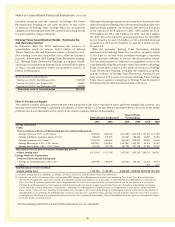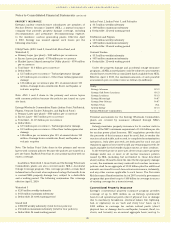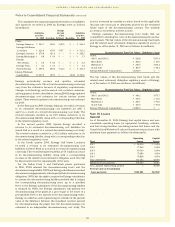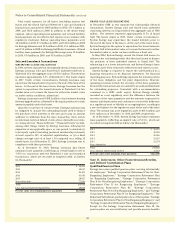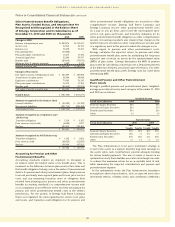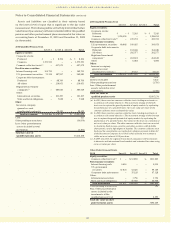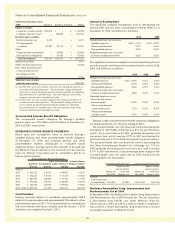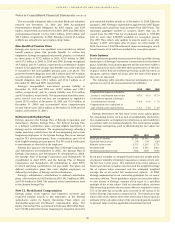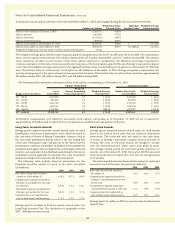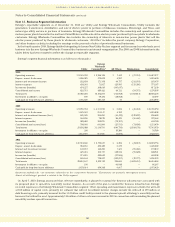Entergy 2010 Annual Report Download - page 98
Download and view the complete annual report
Please find page 98 of the 2010 Entergy annual report below. You can navigate through the pages in the report by either clicking on the pages listed below, or by using the keyword search tool below to find specific information within the annual report.
Notes to Consolidated Financial Statements continued
among the various asset classes. The future market assumptions
used in the optimization study are determined by examining
historical market characteristics of the various asset classes,
and making adjustments to reflect future conditions expected
to prevail over the study period. The following targets and
ranges were established in the study to produce an acceptable
economically efficient plan to manage around the targets:
Qualified Pension
Asset Class Target Range
Domestic Equity Securities 45% 35% to 55%
International Equity Securities 20% 15% to 25%
Total Equity 65% 60% to 70%
Fixed-Income Securities 35% 30% to 40%
Other –% 0% to 10%
Postretirement
Non-Taxable Taxable
Asset Class Target Range Target Range
Domestic Equity
Securities 38% 33% to 43% 35% 30% to 40%
International Equity
Securities 17% 12% to 22% –% –%
Total Equity 55% 50% to 60% 35% 30% to 40%
Fixed-Income Securities 45% 40% to 50% 65% 60% to 70%
Other –% 0% to 5% –% 0% to 5%
The expected long term rate of return of 8.5% for 2010 (8.5%
for 2009) for the qualified pension plans’ assets is based on the
geometric average of the historical annual performance of a
representative portfolio weighted by the target asset allocation
defined in the table above. The time period reflected is a long
dated period spanning several decades.
The expected long term rate of return of 7.75% for 2010
(7.75% for 2009) for the non-taxable postretirement trust assets
is determined using the same methodology described above
for pension assets, but the asset allocation specific to the
postretirement assets is used.
For the taxable postretirement trust assets, the investment
allocation includes a high percentage of tax-exempt fixed income
securities. This asset allocation in combination with the same
methodology employed to determine the expected return for
other trust assets (as described above), with a modification
to reflect applicable taxes, produces an expected long term
rate of return of 5.5% for 2010 (5.5% for 2009) for the taxable
postretirement trust assets.
CONCENTRATIONS OF CREDIT RISK
Entergy’s investment guidelines mandate the avoidance of risk
concentrations. Types of concentrations specified to be avoided
include, but are not limited to, investment concentrations in a
single entity, type of industry, foreign country, geographic area
and individual security issuance. As of December 31, 2010 all
investment managers and assets were materially in compliance
with the approved investment guidelines, therefore there were no
significant concentrations (defined as greater than 10 percent of
plan assets) of risk in Entergy’s pension and other postretirement
benefit plan assets.
Fair Value Measurements
For fiscal years ending after December 31, 2009, fair value
measurements and disclosures for plan assets are required.
Fair value of a financial instrument is the amount that would be
received to sell an asset or paid to transfer a liability in an orderly
transaction between market participants at the measurement
date. Interest bearing cash, treasury notes and bonds, and
common stocks are stated at fair value determined by quoted
market prices. Fixed income securities (corporate, government,
and securitized), are stated at fair value as determined by broker
quotes. Common collective investment trust funds and registered
investment company trust funds are stated at estimated fair value
based on the fair market value of the underlying investments.
The unallocated insurance contract investments are recorded at
contract value, which approximates fair value. The contract value
represents contributions made under the contract, plus interest,
less funds used to pay benefits and contract expenses, and less
distributions to the master trust. The other remaining assets are
U.S. municipal and foreign government bonds stated at fair value
as determined by broker quotes.
The classification levels for fair value are as follows:
n Level 1 - Level 1 inputs are unadjusted quoted prices for
identical assets or liabilities in active markets that the Plan
has the ability to access at the measurement date. Active
markets are those in which transactions for the asset or
liability occur in sufficient frequency and volume to provide
pricing information on an ongoing basis.
n Level 2 - Level 2 inputs are inputs other than quoted prices
included in Level 1 that are, either directly or indirectly,
observable for the asset or liability at the measurement date.
Assets are valued based on prices derived by an independent
party that uses inputs such as benchmark yields, reported
trades, broker/dealer quotes, and issuer spreads. Level 2
inputs include the following:
n quoted prices for similar assets or liabilities in active
markets;
n quoted prices for identical assets or liabilities in inactive
markets;
n inputs other than quoted prices that are observable for the
asset or liability; or
n inputs that are derived principally from or corroborated by
observable market data by correlation or other means.
If an asset or liability has a specified (contractual) term, the
Level 2 input must be observable for substantially the full term
of the asset or liability.
n Level 3 - Level 3 refers to securities valued based on
significant unobservable inputs.
96


